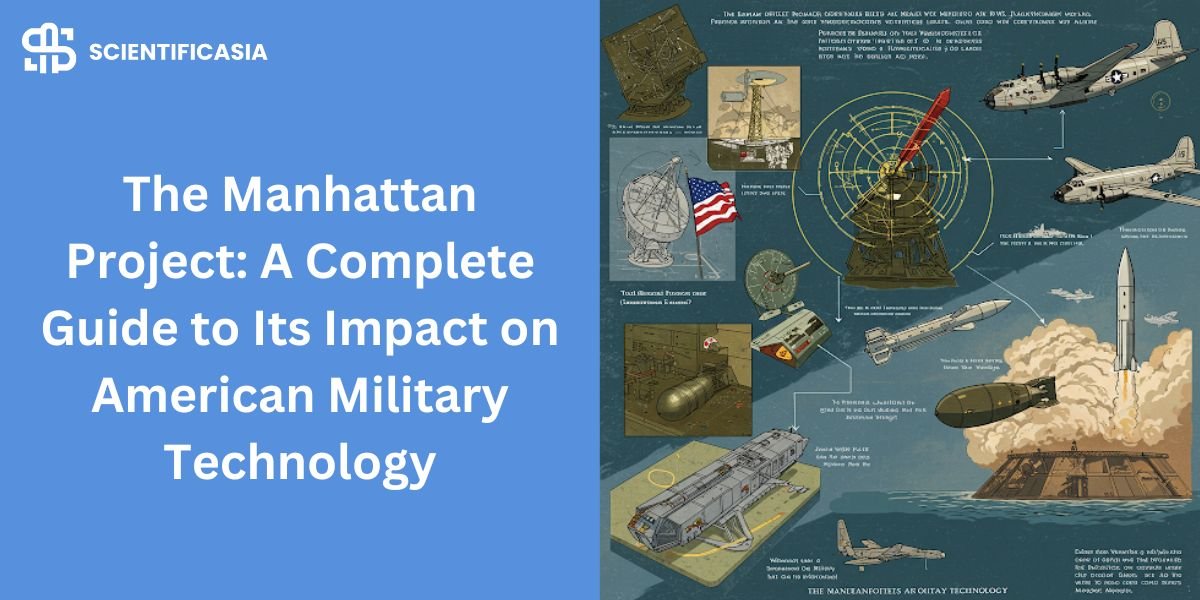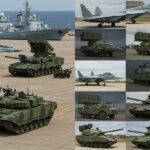Introduction
The Manhattan Project was one of the most ambitious scientific and military undertakings in history. It was a secret U.S. government project during World War II that led to the development of nuclear weapons. This project not only played a crucial role in ending the war but also transformed American military technology, shaping global warfare strategies for decades to come. In this guide, we will explore the history, key figures, technological advancements, and long-term impacts of the Manhattan Project.
Background and Origins of the Manhattan Project
The origins of the Manhattan Project date back to the late 1930s, when scientists discovered nuclear fission—the process of splitting atoms to release massive amounts of energy. With the rise of Nazi Germany and fears that Hitler’s regime might develop an atomic bomb first, the U.S. government decided to accelerate nuclear research.
In 1939, physicists Albert Einstein and Leó Szilárd wrote a letter to President Franklin D. Roosevelt, warning that Germany might be developing nuclear weapons. This led to the establishment of the Advisory Committee on Uranium and, later, the creation of the Manhattan Project in 1942 under the U.S. Army Corps of Engineers.
Key People and Locations
The Manhattan Project involved some of the most brilliant scientific minds of the 20th century. Here are some of the key scientists who played a crucial role in its success:
1. J. Robert Oppenheimer—Scientific Director
- Often called the “father of the atomic bomb.”
- Led research and development at Los Alamos Laboratory.
- Oversaw the successful Trinity test of the first nuclear bomb.
2. Enrico Fermi – Nuclear Physicist
- Created the first self-sustained nuclear chain reaction in 1942 at the University of Chicago.
- Developed nuclear reactor technology used for both energy and weapon production.
3. Niels Bohr – Theoretical Physicist
- Contributed to nuclear fission theory.
- Advised on plutonium bomb design based on his quantum mechanics expertise.
4. Ernest Lawrence – Experimental Physicist
- Invented the cyclotron, a particle accelerator critical for uranium enrichment.
- Pioneered electromagnetic separation methods used at Oak Ridge, Tennessee.
5. Richard Feynman – Theoretical Physicist
- Worked on nuclear bomb calculations and shock wave analysis.
- Played a role in optimizing detonation mechanisms.
6. Edward Teller – Physicist
- Advocated for the development of the hydrogen bomb (H-bomb) after WWII.
- Worked on theoretical calculations for the implosion mechanism.
7. Hans Bethe – Head of Theoretical Division
- Led research on bomb efficiency, neutron transport, and chain reactions.
- Helped develop calculations for nuclear explosions.
8. Leo Szilárd – Nuclear Physicist
- Co-authored the Einstein-Szilárd letter that urged Roosevelt to start atomic bomb research.
- Worked on nuclear reactor designs and plutonium production.
9. Klaus Fuchs – Theoretical Physicist (Later Found to Be a Soviet Spy)
- Helped develop the implosion method for Fat Man (the plutonium bomb).
- Passed nuclear secrets to the Soviet Union, accelerating their atomic program.
10. Glenn T. Seaborg – Chemist
- Discovered plutonium-239, essential for the second atomic bomb.
- Contributed to nuclear chemistry advancements.
11. John von Neumann – Mathematician
- Developed shockwave and implosion calculations for the bomb’s efficiency.
- Played a key role in post-war computer science and weapons modeling.
12. Eugene Wigner – Theoretical Physicist
- Worked on reactor design to produce weapons-grade plutonium.
- Contributed to the physics of neutron diffusion.
The Manhattan Project was carried out across multiple secret locations in the United States, including:
- Los Alamos Laboratory, New Mexico – Designed and built atomic bombs.
- Oak Ridge, Tennessee – Produced enriched uranium for the “Little Boy” bomb.
- Hanford Site, Washington – Produced plutonium for the “Fat Man” bomb.
- University of Chicago – Conducted the first self-sustaining nuclear reaction.
Development of Nuclear Weapons
Two types of atomic bombs were developed under the Manhattan Project:
- Little Boy – A uranium-based bomb dropped on Hiroshima on August 6, 1945.
- Fat Man – A plutonium-based bomb dropped on Nagasaki on August 9, 1945.
Both bombs demonstrated an unprecedented level of destruction, leading to Japan’s surrender and the end of World War II on August 15, 1945.
Challenges and Achievements
The Manhattan Project faced numerous challenges, including:
- Scientific and Engineering Hurdles – Developing nuclear fission weapons required groundbreaking scientific discoveries and engineering solutions.
- Security and Espionage Risks – Maintaining secrecy was crucial, yet Soviet spies infiltrated the project.
- Resource Management – The project consumed enormous resources, including manpower, raw materials, and finances.
Despite these challenges, the project achieved:
- Successful Detonation of Atomic Bombs – First tests at the Trinity Site in July 1945 confirmed the viability of nuclear weapons.
- Revolutionary Scientific Breakthroughs – Pioneered nuclear physics, computing, and advanced engineering techniques.
Technological Advancements
The Manhattan Project significantly advanced several areas of American military technology:
1. Nuclear Physics and Reactor Development
- First self-sustained nuclear chain reaction at the University of Chicago in 1942.
- Development of nuclear reactors for energy and weapon production.
2. Uranium Enrichment and Plutonium Production
- Innovative methods such as gaseous diffusion and electromagnetic separation were pioneered to refine uranium-235.
- Large-scale plutonium production at the Hanford Site revolutionized nuclear fuel processing.
3. High-Speed Computing
- Early computational models and calculations were essential for predicting nuclear reactions and bomb effects.
- Led to the development of advanced computing technologies used in later military technology and scientific applications.
4. Precision Engineering and Detonation Mechanisms
- Development of implosion-based bomb designs for effective nuclear detonation.
- Invention of high-speed detonators and timing mechanisms to ensure bomb effectiveness.
Impact and Legacy
The Manhattan Project fundamentally transformed U.S. military capabilities and had lasting global consequences:
1. Establishment of the U.S. Nuclear Arsenal
- The successful development of nuclear weapons positioned the U.S. as a global superpower.
- Led to the creation of the U.S. Strategic Air Command (SAC), responsible for nuclear deterrence.
2. Military-Industrial Complex and Advanced Weapons Research
- The Manhattan Project established a model for government-funded military research, leading to later programs such as:
- The development of the hydrogen bomb (H-bomb) in the 1950s.
- Missile technology, including intercontinental ballistic missiles (ICBMs).
- The establishment of nuclear-powered submarines and aircraft carriers.
3. Cold War Arms Race and Nuclear Strategy
- The success of the project triggered the Cold War nuclear arms race between the U.S. and the Soviet Union.
- Development of mutually assured destruction (MAD) as a strategic deterrent policy.
4. Advancements in Civilian Applications
- Nuclear technology from the Manhattan Project contributed to nuclear energy production.
- Led to advancements in medical imaging (PET scans), radiation therapy, and space exploration.
Strengths of the Manhattan Project
- Scientific Breakthroughs – Revolutionized physics, chemistry, and engineering.
- Military Superiority – Established the U.S. as the first nuclear-armed nation.
- Rapid Execution – Completed the bomb in less than three years despite massive challenges.
- Strategic Influence – Provided the U.S. with a geopolitical advantage during the Cold War.
Limitations and Ethical Concerns
- Human and Environmental Costs – Exposure to radiation led to long-term health issues for workers and civilians.
- Ethical Debate – The bombings of Hiroshima and Nagasaki killed over 200,000 people, raising moral concerns.
- Nuclear Proliferation – Other nations, including the Soviet Union, developed nuclear weapons, increasing global security risks.
- Arms Race and Global Tension – Initiated an era of high-stakes geopolitical conflict.
Where were the 4 secret sites of the Manhattan Project?
The Manhattan Project was conducted across multiple secret sites in the United States, each playing a crucial role in the development of the atomic bomb. The four main secret locations were:
1. Los Alamos Laboratory (New Mexico) – Scientific Research and Bomb Design
- Purpose: Los Alamos was the central research and design site for the bomb.
- Key Activities:
- Led by J. Robert Oppenheimer, scientists developed both the Little Boy (uranium bomb) and Fat Man (plutonium bomb) designs.
- Conducted theoretical calculations, materials testing, and bomb assembly.
- Successfully detonated the first atomic bomb during the Trinity Test (July 16, 1945).
- Why It Was Chosen: Remote and mountainous terrain provided secrecy and security.
2. Oak Ridge (Tennessee) – Uranium Enrichment
- Purpose: This site focused on the production of enriched uranium for the atomic bomb.
- Key Activities:
- The Y-12 Plant used electromagnetic separation to enrich uranium-235.
- The K-25 Plant used gaseous diffusion for large-scale uranium enrichment.
- The X-10 Graphite Reactor produced the first plutonium samples.
- Why It Was Chosen: The Tennessee Valley’s access to hydroelectric power supported the energy-intensive enrichment process.
3. Hanford Site (Washington) – Plutonium Production
- Purpose: Hanford produced plutonium-239, which was used in the Fat Man bomb dropped on Nagasaki.
- Key Activities:
- Constructed the world’s first industrial-scale nuclear reactors (B-Reactor).
- Produced plutonium through neutron bombardment in uranium fuel rods.
- Processed radioactive materials for bomb development.
- Why It Was Chosen: Its location near the Columbia River provided ample water for cooling nuclear reactors.
4. Chicago Metallurgical Laboratory (Illinois) – First Nuclear Reactor
- Purpose: Conducted early nuclear research and designed nuclear reactors.
- Key Activities:
- Led by Enrico Fermi, the team created the first self-sustaining nuclear chain reaction at the University of Chicago’s Stagg Field (1942).
- Developed plutonium production processes later implemented at Hanford.
- Provided theoretical groundwork for bomb design.
- Why It Was Chosen: The university’s scientific community had the expertise needed for early reactor experiments.
Conclusion
The Manhattan Project was a landmark event in military and scientific history. It not only ended World War II but also reshaped global military strategy, scientific research, and international relations. While it showcased the immense power of human ingenuity, it also highlighted the devastating consequences of nuclear warfare. Today, its legacy continues to influence defense policies, arms control agreements, and technological advancements in both military and civilian fields.




